Critical Appraisal of Emerging Public Health Challenges Report
VerifiedAdded on 2021/02/19
|11
|2120
|27
Report
AI Summary
This report presents a critical appraisal of a research article investigating the relationship between sleep patterns and breast cancer risk in Western Australian women. The article, which employed a case-control study design, examined the association between sleep duration, sleep quality, and breast cancer. The critique meticulously evaluates the study's methodology, including the STROBE checklist, settings, participants, and statistical methods. The report highlights the strengths of the article, such as a clear introduction, systematic data presentation, and alignment with STROBE guidelines, while also addressing limitations like potential selection bias and the failure to identify other contributing factors to breast cancer. The conclusion emphasizes the overall quality of the epidemiological study, the ethical considerations, and the implications of the findings, particularly the lack of a significant relationship between sleep variables and breast cancer risk. This report provides a comprehensive overview of the research, its strengths, and its weaknesses, offering valuable insights into the complexities of public health research.
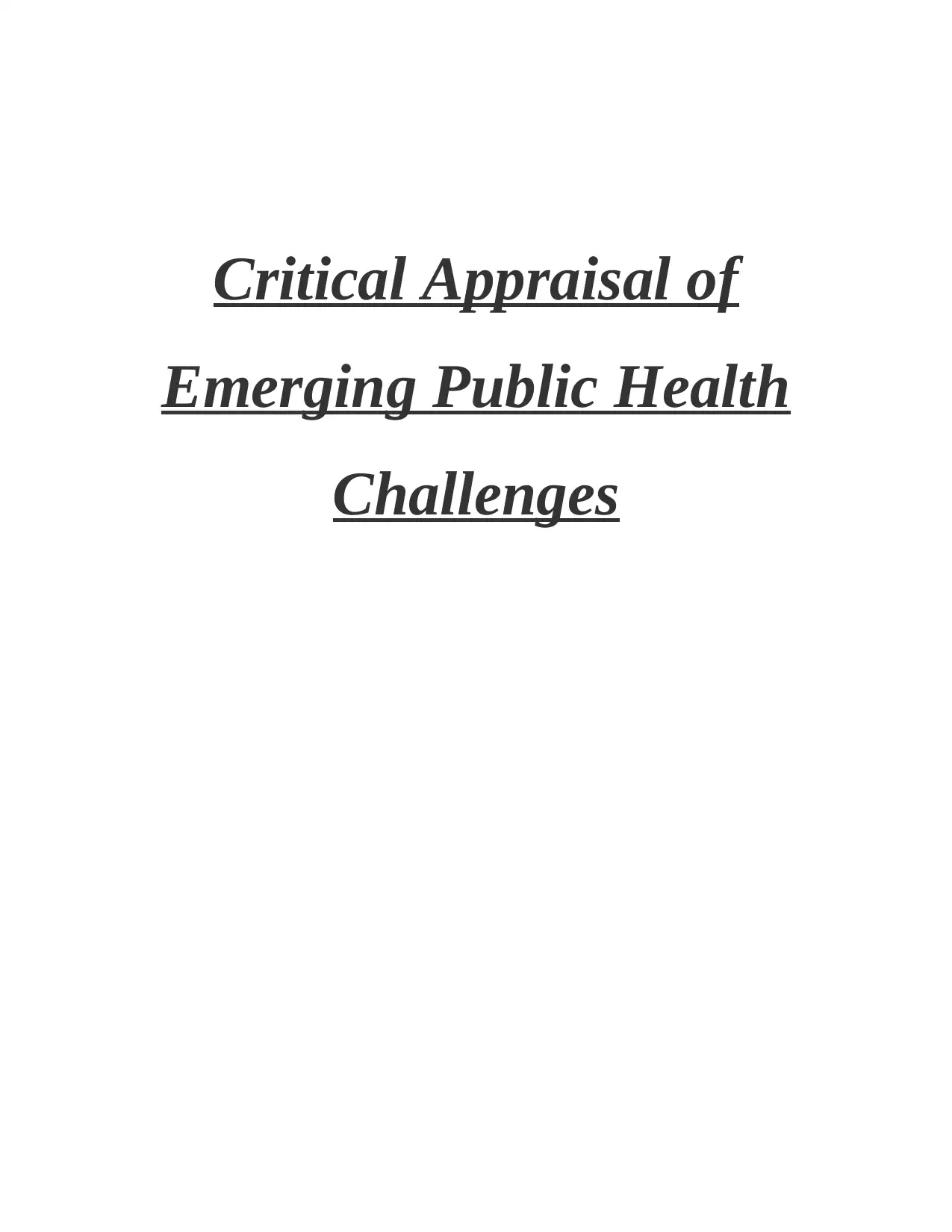
Critical Appraisal of
Emerging Public Health
Challenges
Emerging Public Health
Challenges
Paraphrase This Document
Need a fresh take? Get an instant paraphrase of this document with our AI Paraphraser
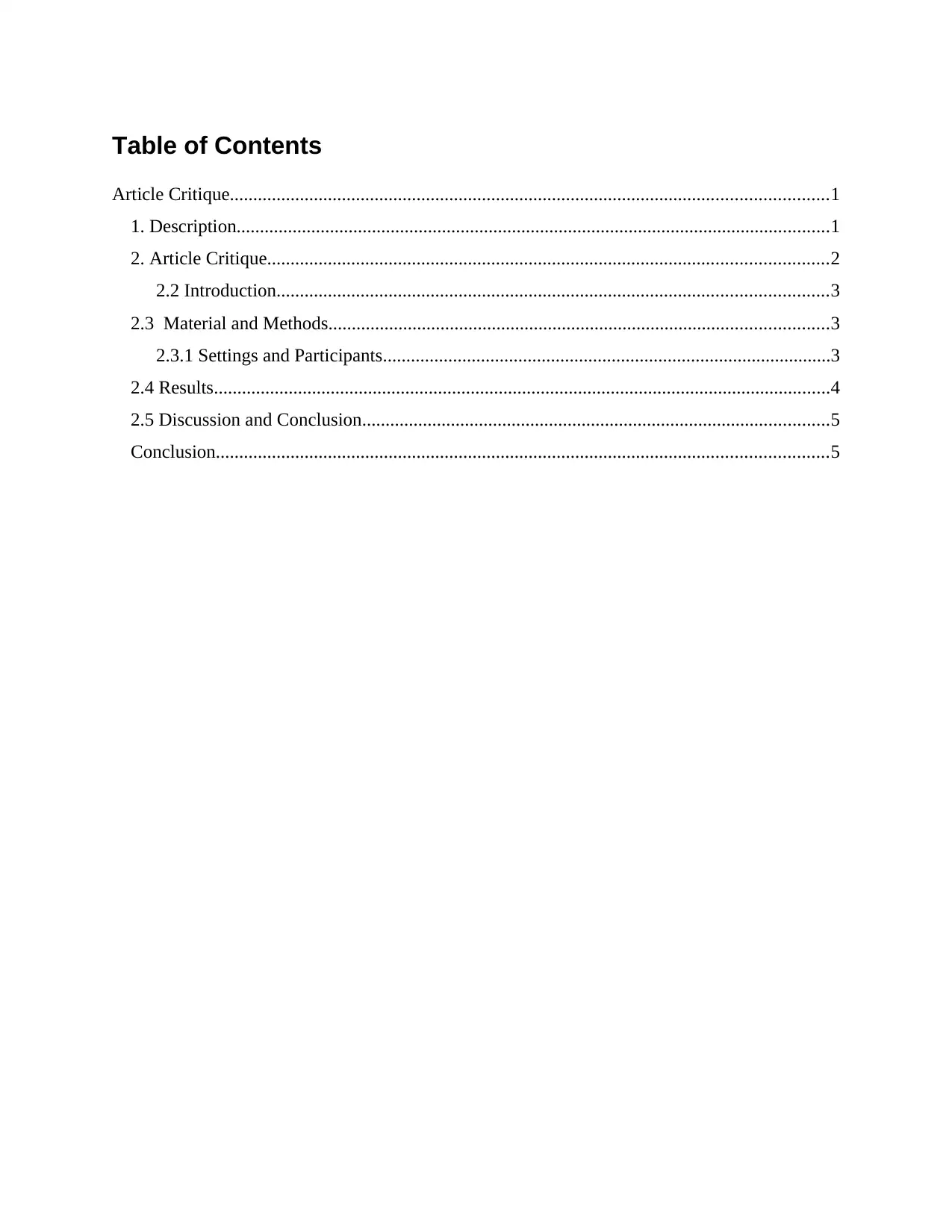
Table of Contents
Article Critique................................................................................................................................1
1. Description...............................................................................................................................1
2. Article Critique........................................................................................................................2
2.2 Introduction......................................................................................................................3
2.3 Material and Methods...........................................................................................................3
2.3.1 Settings and Participants................................................................................................3
2.4 Results....................................................................................................................................4
2.5 Discussion and Conclusion....................................................................................................5
Conclusion...................................................................................................................................5
Article Critique................................................................................................................................1
1. Description...............................................................................................................................1
2. Article Critique........................................................................................................................2
2.2 Introduction......................................................................................................................3
2.3 Material and Methods...........................................................................................................3
2.3.1 Settings and Participants................................................................................................3
2.4 Results....................................................................................................................................4
2.5 Discussion and Conclusion....................................................................................................5
Conclusion...................................................................................................................................5
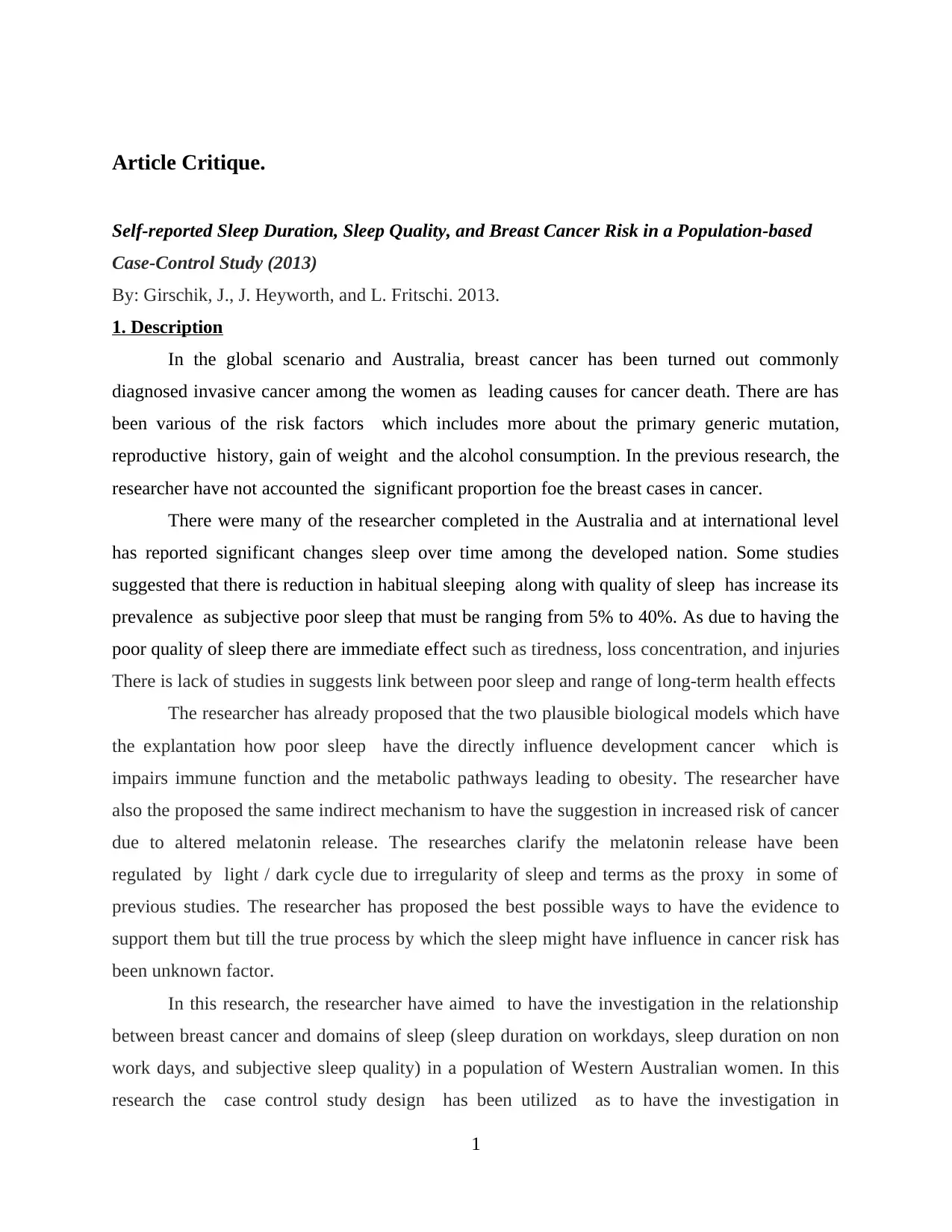
Article Critique.
Self-reported Sleep Duration, Sleep Quality, and Breast Cancer Risk in a Population-based
Case-Control Study (2013)
By: Girschik, J., J. Heyworth, and L. Fritschi. 2013.
1. Description
In the global scenario and Australia, breast cancer has been turned out commonly
diagnosed invasive cancer among the women as leading causes for cancer death. There are has
been various of the risk factors which includes more about the primary generic mutation,
reproductive history, gain of weight and the alcohol consumption. In the previous research, the
researcher have not accounted the significant proportion foe the breast cases in cancer.
There were many of the researcher completed in the Australia and at international level
has reported significant changes sleep over time among the developed nation. Some studies
suggested that there is reduction in habitual sleeping along with quality of sleep has increase its
prevalence as subjective poor sleep that must be ranging from 5% to 40%. As due to having the
poor quality of sleep there are immediate effect such as tiredness, loss concentration, and injuries
There is lack of studies in suggests link between poor sleep and range of long-term health effects
The researcher has already proposed that the two plausible biological models which have
the explantation how poor sleep have the directly influence development cancer which is
impairs immune function and the metabolic pathways leading to obesity. The researcher have
also the proposed the same indirect mechanism to have the suggestion in increased risk of cancer
due to altered melatonin release. The researches clarify the melatonin release have been
regulated by light / dark cycle due to irregularity of sleep and terms as the proxy in some of
previous studies. The researcher has proposed the best possible ways to have the evidence to
support them but till the true process by which the sleep might have influence in cancer risk has
been unknown factor.
In this research, the researcher have aimed to have the investigation in the relationship
between breast cancer and domains of sleep (sleep duration on workdays, sleep duration on non
work days, and subjective sleep quality) in a population of Western Australian women. In this
research the case control study design has been utilized as to have the investigation in
1
Self-reported Sleep Duration, Sleep Quality, and Breast Cancer Risk in a Population-based
Case-Control Study (2013)
By: Girschik, J., J. Heyworth, and L. Fritschi. 2013.
1. Description
In the global scenario and Australia, breast cancer has been turned out commonly
diagnosed invasive cancer among the women as leading causes for cancer death. There are has
been various of the risk factors which includes more about the primary generic mutation,
reproductive history, gain of weight and the alcohol consumption. In the previous research, the
researcher have not accounted the significant proportion foe the breast cases in cancer.
There were many of the researcher completed in the Australia and at international level
has reported significant changes sleep over time among the developed nation. Some studies
suggested that there is reduction in habitual sleeping along with quality of sleep has increase its
prevalence as subjective poor sleep that must be ranging from 5% to 40%. As due to having the
poor quality of sleep there are immediate effect such as tiredness, loss concentration, and injuries
There is lack of studies in suggests link between poor sleep and range of long-term health effects
The researcher has already proposed that the two plausible biological models which have
the explantation how poor sleep have the directly influence development cancer which is
impairs immune function and the metabolic pathways leading to obesity. The researcher have
also the proposed the same indirect mechanism to have the suggestion in increased risk of cancer
due to altered melatonin release. The researches clarify the melatonin release have been
regulated by light / dark cycle due to irregularity of sleep and terms as the proxy in some of
previous studies. The researcher has proposed the best possible ways to have the evidence to
support them but till the true process by which the sleep might have influence in cancer risk has
been unknown factor.
In this research, the researcher have aimed to have the investigation in the relationship
between breast cancer and domains of sleep (sleep duration on workdays, sleep duration on non
work days, and subjective sleep quality) in a population of Western Australian women. In this
research the case control study design has been utilized as to have the investigation in
1
⊘ This is a preview!⊘
Do you want full access?
Subscribe today to unlock all pages.

Trusted by 1+ million students worldwide
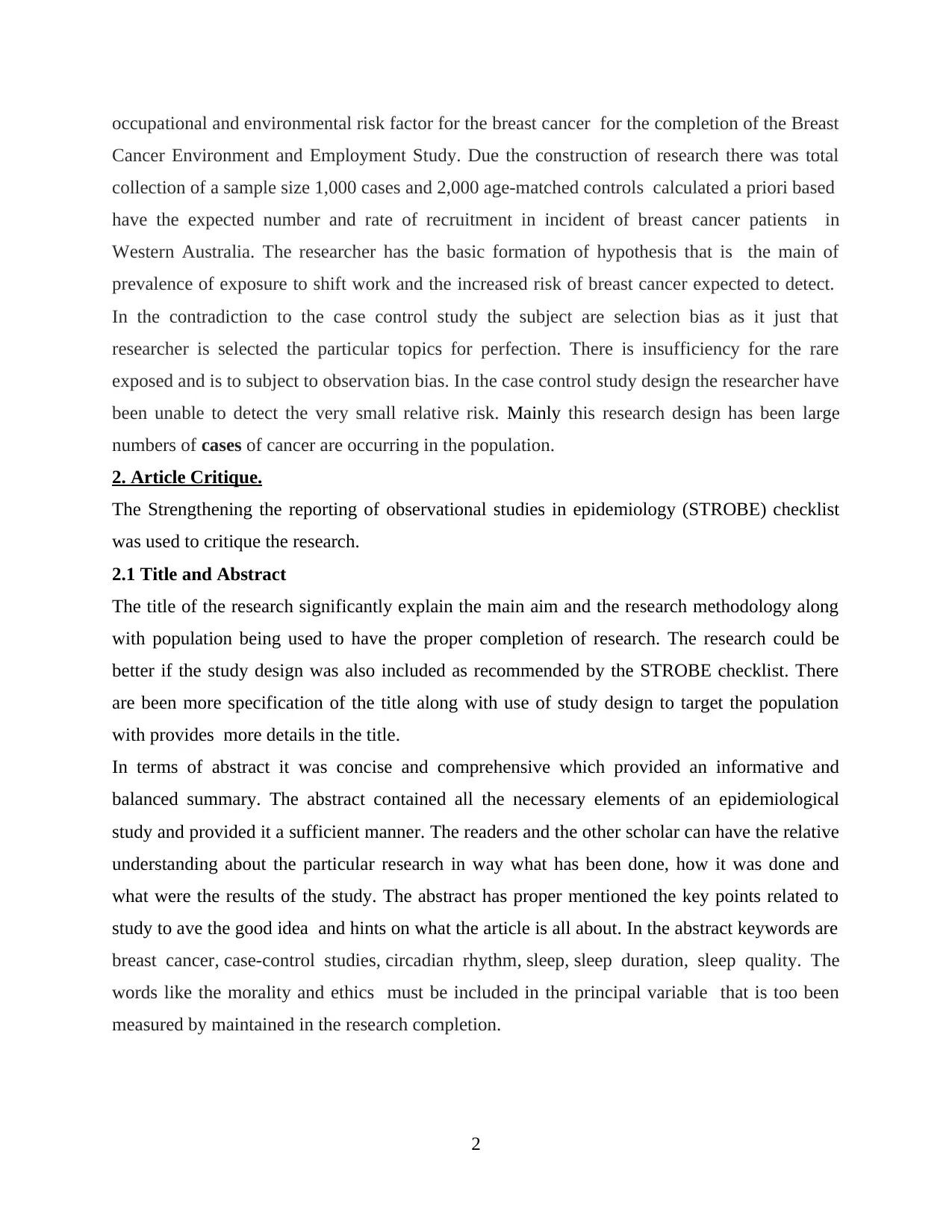
occupational and environmental risk factor for the breast cancer for the completion of the Breast
Cancer Environment and Employment Study. Due the construction of research there was total
collection of a sample size 1,000 cases and 2,000 age-matched controls calculated a priori based
have the expected number and rate of recruitment in incident of breast cancer patients in
Western Australia. The researcher has the basic formation of hypothesis that is the main of
prevalence of exposure to shift work and the increased risk of breast cancer expected to detect.
In the contradiction to the case control study the subject are selection bias as it just that
researcher is selected the particular topics for perfection. There is insufficiency for the rare
exposed and is to subject to observation bias. In the case control study design the researcher have
been unable to detect the very small relative risk. Mainly this research design has been large
numbers of cases of cancer are occurring in the population.
2. Article Critique.
The Strengthening the reporting of observational studies in epidemiology (STROBE) checklist
was used to critique the research.
2.1 Title and Abstract
The title of the research significantly explain the main aim and the research methodology along
with population being used to have the proper completion of research. The research could be
better if the study design was also included as recommended by the STROBE checklist. There
are been more specification of the title along with use of study design to target the population
with provides more details in the title.
In terms of abstract it was concise and comprehensive which provided an informative and
balanced summary. The abstract contained all the necessary elements of an epidemiological
study and provided it a sufficient manner. The readers and the other scholar can have the relative
understanding about the particular research in way what has been done, how it was done and
what were the results of the study. The abstract has proper mentioned the key points related to
study to ave the good idea and hints on what the article is all about. In the abstract keywords are
breast cancer, case-control studies, circadian rhythm, sleep, sleep duration, sleep quality. The
words like the morality and ethics must be included in the principal variable that is too been
measured by maintained in the research completion.
2
Cancer Environment and Employment Study. Due the construction of research there was total
collection of a sample size 1,000 cases and 2,000 age-matched controls calculated a priori based
have the expected number and rate of recruitment in incident of breast cancer patients in
Western Australia. The researcher has the basic formation of hypothesis that is the main of
prevalence of exposure to shift work and the increased risk of breast cancer expected to detect.
In the contradiction to the case control study the subject are selection bias as it just that
researcher is selected the particular topics for perfection. There is insufficiency for the rare
exposed and is to subject to observation bias. In the case control study design the researcher have
been unable to detect the very small relative risk. Mainly this research design has been large
numbers of cases of cancer are occurring in the population.
2. Article Critique.
The Strengthening the reporting of observational studies in epidemiology (STROBE) checklist
was used to critique the research.
2.1 Title and Abstract
The title of the research significantly explain the main aim and the research methodology along
with population being used to have the proper completion of research. The research could be
better if the study design was also included as recommended by the STROBE checklist. There
are been more specification of the title along with use of study design to target the population
with provides more details in the title.
In terms of abstract it was concise and comprehensive which provided an informative and
balanced summary. The abstract contained all the necessary elements of an epidemiological
study and provided it a sufficient manner. The readers and the other scholar can have the relative
understanding about the particular research in way what has been done, how it was done and
what were the results of the study. The abstract has proper mentioned the key points related to
study to ave the good idea and hints on what the article is all about. In the abstract keywords are
breast cancer, case-control studies, circadian rhythm, sleep, sleep duration, sleep quality. The
words like the morality and ethics must be included in the principal variable that is too been
measured by maintained in the research completion.
2
Paraphrase This Document
Need a fresh take? Get an instant paraphrase of this document with our AI Paraphraser
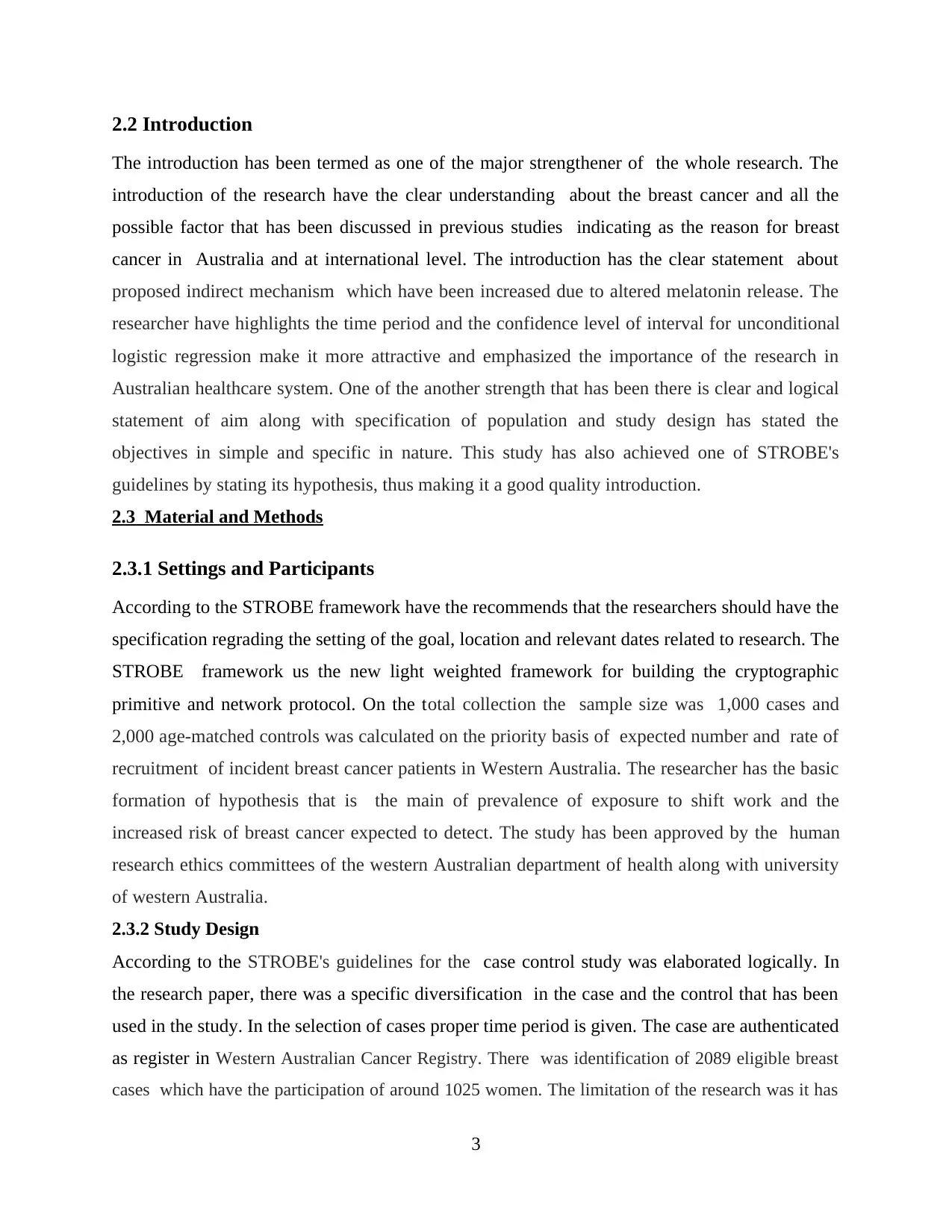
2.2 Introduction
The introduction has been termed as one of the major strengthener of the whole research. The
introduction of the research have the clear understanding about the breast cancer and all the
possible factor that has been discussed in previous studies indicating as the reason for breast
cancer in Australia and at international level. The introduction has the clear statement about
proposed indirect mechanism which have been increased due to altered melatonin release. The
researcher have highlights the time period and the confidence level of interval for unconditional
logistic regression make it more attractive and emphasized the importance of the research in
Australian healthcare system. One of the another strength that has been there is clear and logical
statement of aim along with specification of population and study design has stated the
objectives in simple and specific in nature. This study has also achieved one of STROBE's
guidelines by stating its hypothesis, thus making it a good quality introduction.
2.3 Material and Methods
2.3.1 Settings and Participants
According to the STROBE framework have the recommends that the researchers should have the
specification regrading the setting of the goal, location and relevant dates related to research. The
STROBE framework us the new light weighted framework for building the cryptographic
primitive and network protocol. On the total collection the sample size was 1,000 cases and
2,000 age-matched controls was calculated on the priority basis of expected number and rate of
recruitment of incident breast cancer patients in Western Australia. The researcher has the basic
formation of hypothesis that is the main of prevalence of exposure to shift work and the
increased risk of breast cancer expected to detect. The study has been approved by the human
research ethics committees of the western Australian department of health along with university
of western Australia.
2.3.2 Study Design
According to the STROBE's guidelines for the case control study was elaborated logically. In
the research paper, there was a specific diversification in the case and the control that has been
used in the study. In the selection of cases proper time period is given. The case are authenticated
as register in Western Australian Cancer Registry. There was identification of 2089 eligible breast
cases which have the participation of around 1025 women. The limitation of the research was it has
3
The introduction has been termed as one of the major strengthener of the whole research. The
introduction of the research have the clear understanding about the breast cancer and all the
possible factor that has been discussed in previous studies indicating as the reason for breast
cancer in Australia and at international level. The introduction has the clear statement about
proposed indirect mechanism which have been increased due to altered melatonin release. The
researcher have highlights the time period and the confidence level of interval for unconditional
logistic regression make it more attractive and emphasized the importance of the research in
Australian healthcare system. One of the another strength that has been there is clear and logical
statement of aim along with specification of population and study design has stated the
objectives in simple and specific in nature. This study has also achieved one of STROBE's
guidelines by stating its hypothesis, thus making it a good quality introduction.
2.3 Material and Methods
2.3.1 Settings and Participants
According to the STROBE framework have the recommends that the researchers should have the
specification regrading the setting of the goal, location and relevant dates related to research. The
STROBE framework us the new light weighted framework for building the cryptographic
primitive and network protocol. On the total collection the sample size was 1,000 cases and
2,000 age-matched controls was calculated on the priority basis of expected number and rate of
recruitment of incident breast cancer patients in Western Australia. The researcher has the basic
formation of hypothesis that is the main of prevalence of exposure to shift work and the
increased risk of breast cancer expected to detect. The study has been approved by the human
research ethics committees of the western Australian department of health along with university
of western Australia.
2.3.2 Study Design
According to the STROBE's guidelines for the case control study was elaborated logically. In
the research paper, there was a specific diversification in the case and the control that has been
used in the study. In the selection of cases proper time period is given. The case are authenticated
as register in Western Australian Cancer Registry. There was identification of 2089 eligible breast
cases which have the participation of around 1025 women. The limitation of the research was it has
3
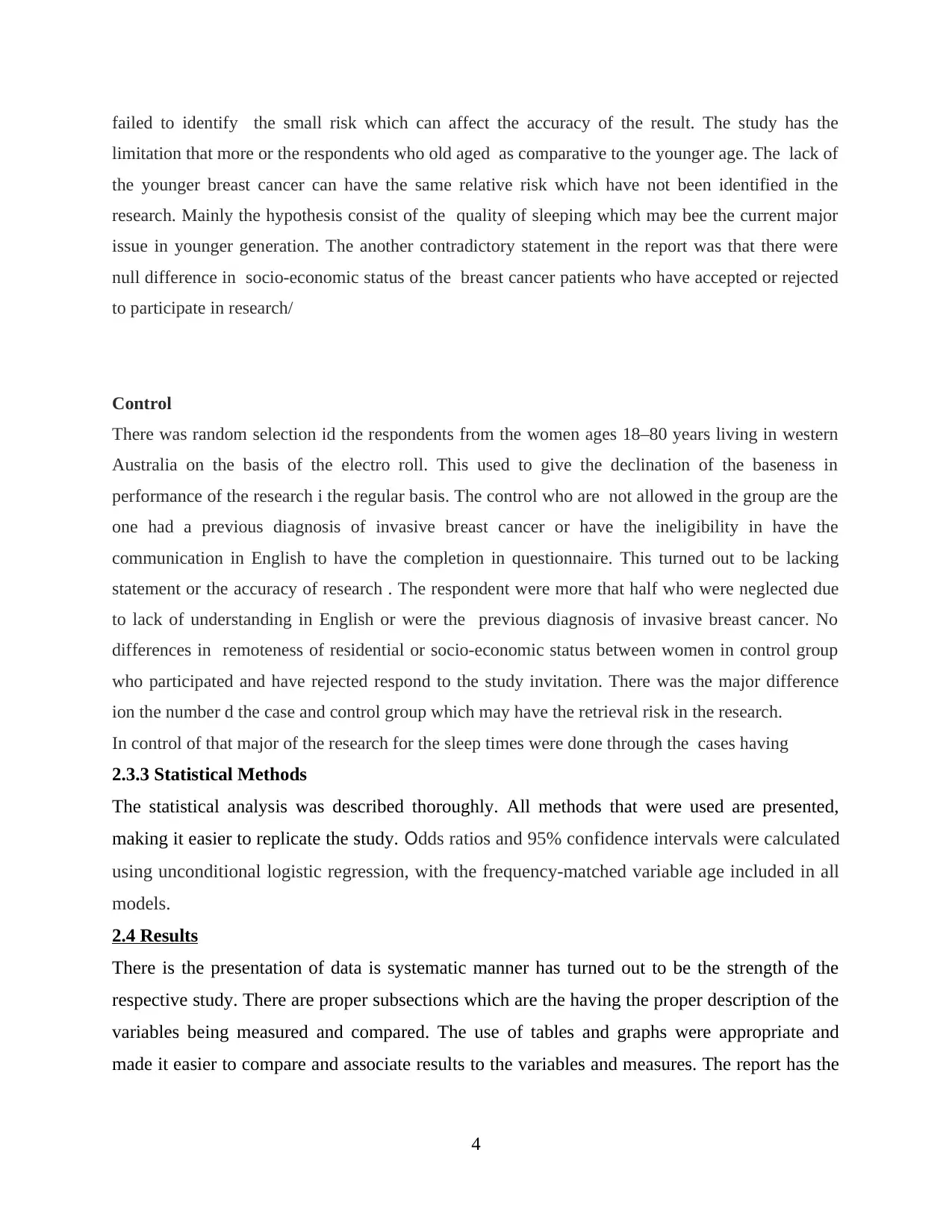
failed to identify the small risk which can affect the accuracy of the result. The study has the
limitation that more or the respondents who old aged as comparative to the younger age. The lack of
the younger breast cancer can have the same relative risk which have not been identified in the
research. Mainly the hypothesis consist of the quality of sleeping which may bee the current major
issue in younger generation. The another contradictory statement in the report was that there were
null difference in socio-economic status of the breast cancer patients who have accepted or rejected
to participate in research/
Control
There was random selection id the respondents from the women ages 18–80 years living in western
Australia on the basis of the electro roll. This used to give the declination of the baseness in
performance of the research i the regular basis. The control who are not allowed in the group are the
one had a previous diagnosis of invasive breast cancer or have the ineligibility in have the
communication in English to have the completion in questionnaire. This turned out to be lacking
statement or the accuracy of research . The respondent were more that half who were neglected due
to lack of understanding in English or were the previous diagnosis of invasive breast cancer. No
differences in remoteness of residential or socio-economic status between women in control group
who participated and have rejected respond to the study invitation. There was the major difference
ion the number d the case and control group which may have the retrieval risk in the research.
In control of that major of the research for the sleep times were done through the cases having
2.3.3 Statistical Methods
The statistical analysis was described thoroughly. All methods that were used are presented,
making it easier to replicate the study. Odds ratios and 95% confidence intervals were calculated
using unconditional logistic regression, with the frequency-matched variable age included in all
models.
2.4 Results
There is the presentation of data is systematic manner has turned out to be the strength of the
respective study. There are proper subsections which are the having the proper description of the
variables being measured and compared. The use of tables and graphs were appropriate and
made it easier to compare and associate results to the variables and measures. The report has the
4
limitation that more or the respondents who old aged as comparative to the younger age. The lack of
the younger breast cancer can have the same relative risk which have not been identified in the
research. Mainly the hypothesis consist of the quality of sleeping which may bee the current major
issue in younger generation. The another contradictory statement in the report was that there were
null difference in socio-economic status of the breast cancer patients who have accepted or rejected
to participate in research/
Control
There was random selection id the respondents from the women ages 18–80 years living in western
Australia on the basis of the electro roll. This used to give the declination of the baseness in
performance of the research i the regular basis. The control who are not allowed in the group are the
one had a previous diagnosis of invasive breast cancer or have the ineligibility in have the
communication in English to have the completion in questionnaire. This turned out to be lacking
statement or the accuracy of research . The respondent were more that half who were neglected due
to lack of understanding in English or were the previous diagnosis of invasive breast cancer. No
differences in remoteness of residential or socio-economic status between women in control group
who participated and have rejected respond to the study invitation. There was the major difference
ion the number d the case and control group which may have the retrieval risk in the research.
In control of that major of the research for the sleep times were done through the cases having
2.3.3 Statistical Methods
The statistical analysis was described thoroughly. All methods that were used are presented,
making it easier to replicate the study. Odds ratios and 95% confidence intervals were calculated
using unconditional logistic regression, with the frequency-matched variable age included in all
models.
2.4 Results
There is the presentation of data is systematic manner has turned out to be the strength of the
respective study. There are proper subsections which are the having the proper description of the
variables being measured and compared. The use of tables and graphs were appropriate and
made it easier to compare and associate results to the variables and measures. The report has the
4
⊘ This is a preview!⊘
Do you want full access?
Subscribe today to unlock all pages.

Trusted by 1+ million students worldwide
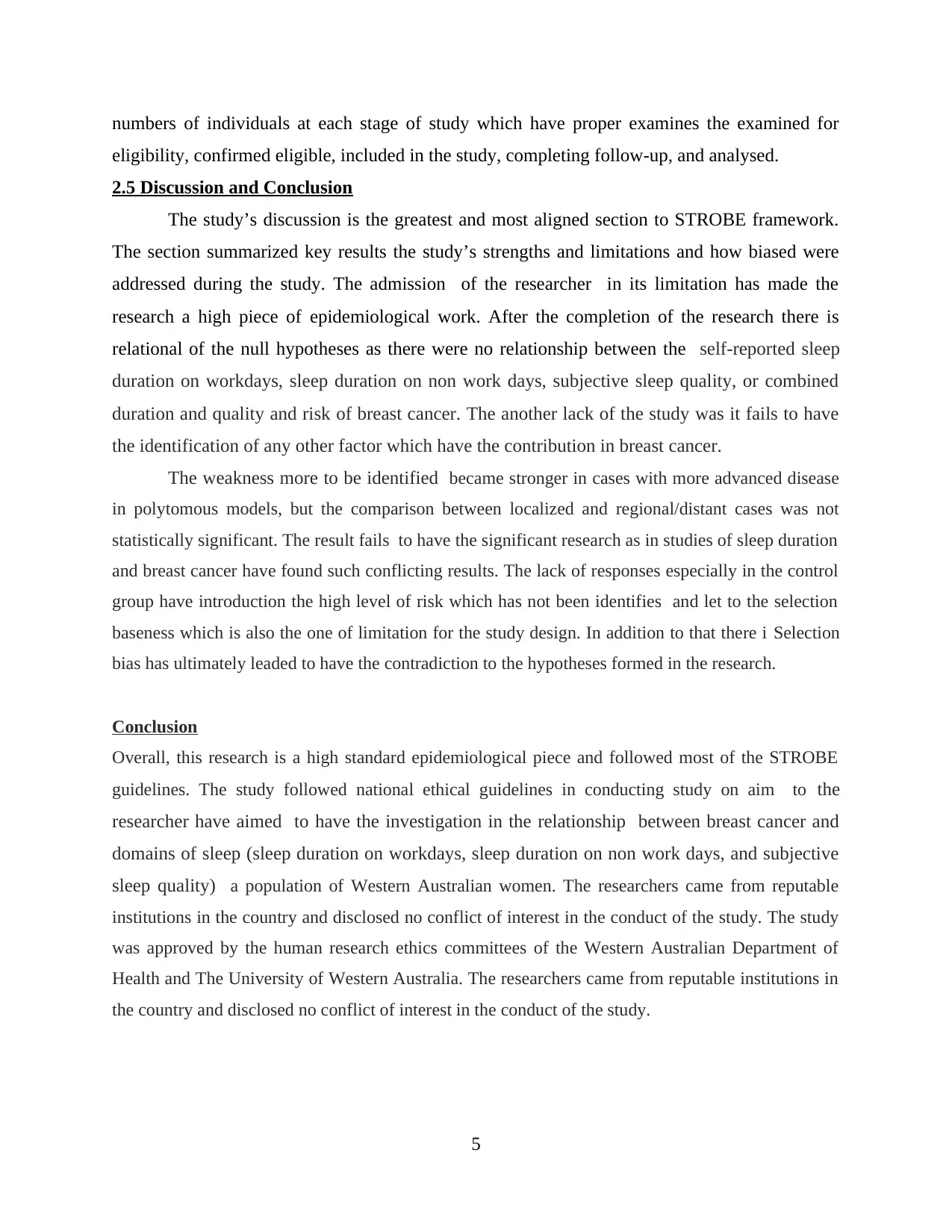
numbers of individuals at each stage of study which have proper examines the examined for
eligibility, confirmed eligible, included in the study, completing follow-up, and analysed.
2.5 Discussion and Conclusion
The study’s discussion is the greatest and most aligned section to STROBE framework.
The section summarized key results the study’s strengths and limitations and how biased were
addressed during the study. The admission of the researcher in its limitation has made the
research a high piece of epidemiological work. After the completion of the research there is
relational of the null hypotheses as there were no relationship between the self-reported sleep
duration on workdays, sleep duration on non work days, subjective sleep quality, or combined
duration and quality and risk of breast cancer. The another lack of the study was it fails to have
the identification of any other factor which have the contribution in breast cancer.
The weakness more to be identified became stronger in cases with more advanced disease
in polytomous models, but the comparison between localized and regional/distant cases was not
statistically significant. The result fails to have the significant research as in studies of sleep duration
and breast cancer have found such conflicting results. The lack of responses especially in the control
group have introduction the high level of risk which has not been identifies and let to the selection
baseness which is also the one of limitation for the study design. In addition to that there i Selection
bias has ultimately leaded to have the contradiction to the hypotheses formed in the research.
Conclusion
Overall, this research is a high standard epidemiological piece and followed most of the STROBE
guidelines. The study followed national ethical guidelines in conducting study on aim to the
researcher have aimed to have the investigation in the relationship between breast cancer and
domains of sleep (sleep duration on workdays, sleep duration on non work days, and subjective
sleep quality) a population of Western Australian women. The researchers came from reputable
institutions in the country and disclosed no conflict of interest in the conduct of the study. The study
was approved by the human research ethics committees of the Western Australian Department of
Health and The University of Western Australia. The researchers came from reputable institutions in
the country and disclosed no conflict of interest in the conduct of the study.
5
eligibility, confirmed eligible, included in the study, completing follow-up, and analysed.
2.5 Discussion and Conclusion
The study’s discussion is the greatest and most aligned section to STROBE framework.
The section summarized key results the study’s strengths and limitations and how biased were
addressed during the study. The admission of the researcher in its limitation has made the
research a high piece of epidemiological work. After the completion of the research there is
relational of the null hypotheses as there were no relationship between the self-reported sleep
duration on workdays, sleep duration on non work days, subjective sleep quality, or combined
duration and quality and risk of breast cancer. The another lack of the study was it fails to have
the identification of any other factor which have the contribution in breast cancer.
The weakness more to be identified became stronger in cases with more advanced disease
in polytomous models, but the comparison between localized and regional/distant cases was not
statistically significant. The result fails to have the significant research as in studies of sleep duration
and breast cancer have found such conflicting results. The lack of responses especially in the control
group have introduction the high level of risk which has not been identifies and let to the selection
baseness which is also the one of limitation for the study design. In addition to that there i Selection
bias has ultimately leaded to have the contradiction to the hypotheses formed in the research.
Conclusion
Overall, this research is a high standard epidemiological piece and followed most of the STROBE
guidelines. The study followed national ethical guidelines in conducting study on aim to the
researcher have aimed to have the investigation in the relationship between breast cancer and
domains of sleep (sleep duration on workdays, sleep duration on non work days, and subjective
sleep quality) a population of Western Australian women. The researchers came from reputable
institutions in the country and disclosed no conflict of interest in the conduct of the study. The study
was approved by the human research ethics committees of the Western Australian Department of
Health and The University of Western Australia. The researchers came from reputable institutions in
the country and disclosed no conflict of interest in the conduct of the study.
5
Paraphrase This Document
Need a fresh take? Get an instant paraphrase of this document with our AI Paraphraser

6

7
⊘ This is a preview!⊘
Do you want full access?
Subscribe today to unlock all pages.

Trusted by 1+ million students worldwide

8
Paraphrase This Document
Need a fresh take? Get an instant paraphrase of this document with our AI Paraphraser

9
1 out of 11
Related Documents
Your All-in-One AI-Powered Toolkit for Academic Success.
+13062052269
info@desklib.com
Available 24*7 on WhatsApp / Email
![[object Object]](/_next/static/media/star-bottom.7253800d.svg)
Unlock your academic potential
Copyright © 2020–2025 A2Z Services. All Rights Reserved. Developed and managed by ZUCOL.





